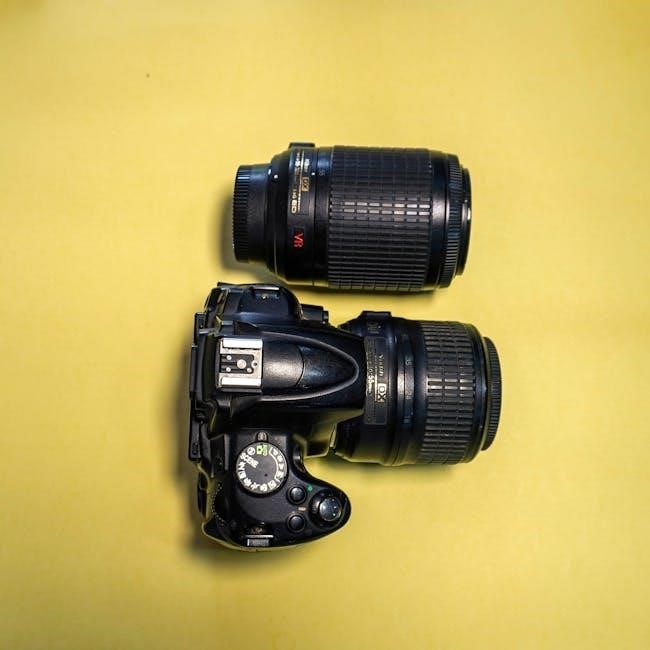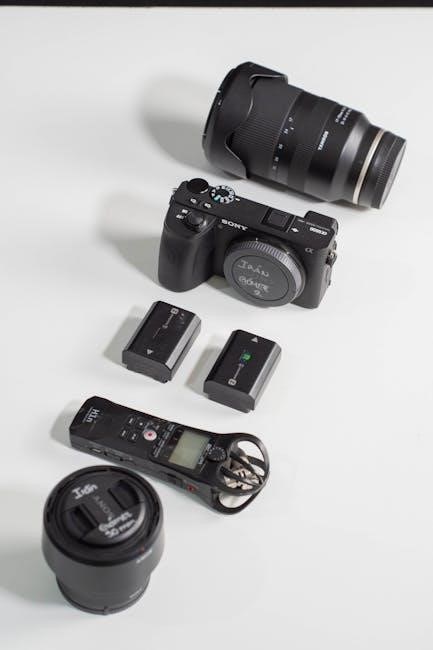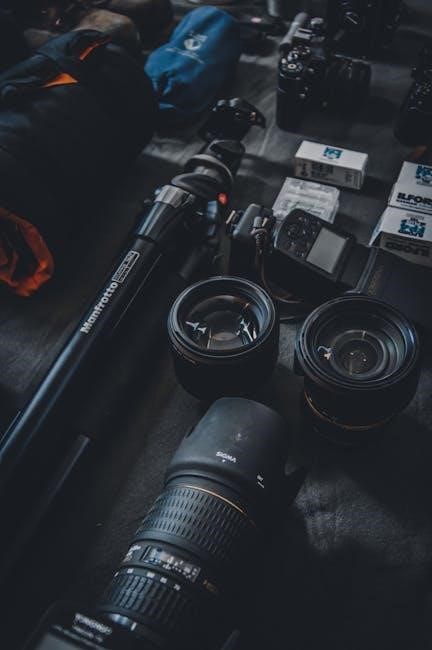Welcome to the Nikon Z8 Setup Guide, your comprehensive resource for mastering this powerful camera. Designed for both beginners and experienced photographers, this guide provides step-by-step instructions to optimize your Z8, ensuring you unlock its full potential for stunning photography.
1.1 Overview of the Nikon Z8 Camera
The Nikon Z8 is a high-performance, full-frame mirrorless camera designed for professional photographers and enthusiasts. It features a 45.7MP stacked CMOS sensor, delivering exceptional image quality and speed. With its compact and durable design, the Z8 offers advanced autofocus capabilities, including subject detection and tracking. It supports fast continuous shooting and 4K video recording, making it versatile for various photography needs. The camera is compatible with CFexpress, XQD, and SD memory cards, ensuring reliable storage solutions. Its intuitive interface and customizable controls allow users to tailor settings to their preferences. Whether for wildlife, portrait, or landscape photography, the Z8 is a powerful tool for capturing stunning images with precision and ease.
1.2 Importance of Proper Camera Setup
Proper camera setup is crucial for unlocking the Nikon Z8’s full potential. A well-configured camera ensures optimal performance, personalized to your shooting style. Misconfigured settings can lead to subpar image quality or missed shots. By setting up correctly, you avoid common issues like incorrect autofocus behavior or memory card errors. Proper setup also enhances efficiency, allowing you to focus on creativity rather than technical adjustments. Whether you’re capturing fast action or precise portraits, a tailored configuration ensures consistent results. This guide provides clear steps to help you customize and optimize your Z8, preventing potential pitfalls and elevating your photography experience.

Essential Camera Setup Steps
Mastering the Nikon Z8 begins with essential setup steps. Start with initial configuration, ensuring firmware is updated to the latest version for optimal performance and functionality. Properly organizing memory cards and storage settings is also critical for efficient workflow and preventing data loss. These foundational steps ensure your camera is ready for any photography situation, allowing you to focus on capturing stunning images with confidence and precision.
2.1 Initial Camera Configuration
Begin by powering on your Nikon Z8 and navigating to the main menu. Start with date, time, and language settings for proper organization. Check the lens mount for any issues, as some Z8 bodies may have compatibility problems. Insert a compatible memory card, such as CFexpress, XQD, or SD, ensuring it’s formatted in-camera. Set the camera to Manual mode for full control. Customize initial settings like autofocus modes and metering patterns based on your shooting style. Familiarize yourself with the menu layout, including options for image quality, white balance, and ISO sensitivity. Proper initial setup ensures a smooth shooting experience and optimizes the camera’s performance for your needs.
2.2 Updating Firmware to the Latest Version
To ensure optimal performance, update your Nikon Z8’s firmware to the latest version. Visit the official Nikon website and download the firmware compatible with your camera. Use a fully charged battery and a formatted memory card (CFexpress, XQD, or SD) to perform the update. Copy the firmware file to the memory card’s root directory and navigate to the Setup Menu > Firmware Version to initiate the update. Avoid turning off the camera or removing the memory card during the process. Once installed, restart the camera and verify the firmware version in the menu to confirm the update was successful. Regular firmware updates enhance functionality and resolve potential issues.
Understanding the Nikon Z8 Menu System
The Nikon Z8’s menu system is designed for intuitive navigation, offering quick access to shooting, playback, and setup options. Customize preferences to streamline your workflow and optimize camera settings for enhanced performance. This section helps you master the menu structure, ensuring a seamless and efficient shooting experience tailored to your needs.
3.1 Navigating the Main Menu Options
The Nikon Z8’s main menu is structured into clear categories, including Shooting, Playback, and Setup menus, making it easy to locate specific settings. Use the multi-selector to scroll through options and press OK to access sub-menus. The Shooting Menu allows adjustments like image quality, white balance, and autofocus modes, while the Playback Menu offers options for reviewing and managing your photos. The Setup Menu handles camera configurations such as firmware updates, language selection, and date/time settings. Navigating these menus is straightforward, with clear labels and logical organization. This section will guide you through efficiently exploring and adjusting these options to tailor the camera to your preferences and shooting style.
3.2 Customizing Menu Preferences
Customizing the Nikon Z8’s menu preferences allows you to tailor the camera to your unique needs, enhancing efficiency and creativity. The “My Menu” feature enables you to create a personalized list of frequently used settings, accessible with just a few button presses. Additionally, custom controls let you assign specific functions to buttons and dials, streamlining your workflow. By organizing the menu system to prioritize your most-used options, you can reduce time spent navigating through menus during shoots. This customization ensures that your camera is optimized for your shooting style, making it easier to focus on capturing the perfect shot. Explore these features to create a setup that aligns with your photographic goals and preferences.

Customizing Camera Controls
Customizing the Nikon Z8’s controls empowers photographers to streamline their workflow. Assign functions to buttons, personalize shooting modes, and optimize dials for efficient operation during shoots.
4.1 Assigning Functions to Custom Buttons
Assigning functions to the Nikon Z8’s custom buttons allows photographers to streamline their workflow. Users can assign frequently used functions, such as autofocus modes, white balance, or exposure compensation, to the camera’s customizable buttons. This feature enhances efficiency and comfort during shooting sessions. By personalizing button assignments, photographers can quickly access their preferred settings without navigating through menus. The Z8’s customization options ensure that every button works in harmony with the photographer’s unique style, making the camera an extension of their creative process. This level of control is especially beneficial for professionals who require precision and speed in high-pressure situations. Proper button assignment can significantly enhance the overall shooting experience, making it more intuitive and enjoyable.
4.2 Configuring Custom Shooting Modes
Configuring custom shooting modes on the Nikon Z8 allows photographers to tailor settings for specific scenarios, enhancing workflow efficiency. Users can save preferred combinations of ISO, aperture, shutter speed, and autofocus settings for quick access. For example, a mode for portraits might prioritize wide apertures, while a landscape mode could emphasize depth of field. These custom modes can be named and organized for easy retrieval via the mode button or menu. This feature is particularly useful for photographers who frequently switch between genres or lighting conditions, as it saves time and ensures consistent results. By leveraging custom shooting modes, photographers can adapt to diverse situations seamlessly, maintaining creative control and focus on their subjects.

Optimizing Autofocus Settings
Optimize the Nikon Z8’s autofocus for precise and sharp images. Adjust settings based on your subject’s movement and lighting conditions for enhanced performance in various shooting scenarios.
5.1 Understanding Autofocus Modes
The Nikon Z8 offers multiple autofocus modes to suit different shooting scenarios. Single AF (AF-S) locks focus on a stationary subject, ideal for portraits and still scenes. Continuous AF (AF-C) tracks moving subjects, perfect for wildlife or sports photography. Auto AF (AF-A) automatically switches between modes based on subject movement. Additionally, the Z8 features advanced Eye AF and Subject Tracking, enhancing focus accuracy on people and objects. Understanding these modes ensures you can adapt to any situation, capturing sharp images consistently.

5.2 Fine-Tuning Autofocus for Precision
Fine-tuning the autofocus on your Nikon Z8 ensures optimal performance and sharp images. Start by using the camera’s built-in autofocus calibration tools to adjust focus accuracy for specific lenses. Many photographers calibrate their lenses to eliminate front or back focusing issues. Additionally, enabling features like Eye AF and Subject Tracking enhances focus precision, especially for dynamic subjects. Regularly updating firmware and cleaning the camera’s autofocus sensor can also improve accuracy. Testing autofocus performance in different lighting conditions and scenarios helps identify any adjustments needed. By refining these settings, you can achieve consistently precise focus, elevating the quality of your photography.
Memory and Storage Management
The Nikon Z8 supports CFexpress, XQD, SD, SDHC, and SDXC cards. Using high-speed memory cards ensures optimal performance. Proper storage management is crucial for efficient workflow.
6.1 Choosing the Right Memory Cards
Selecting the right memory cards for your Nikon Z8 is essential for optimal performance. The camera supports CFexpress (Type B), XQD, SD, SDHC, and SDXC cards. For high-speed shooting and video recording, CFexpress cards are recommended due to their faster read/write speeds. When using SD cards, opt for high-speed U3 or V30-rated options to ensure smooth operation. Consider the storage capacity based on your workflow—64GB or higher cards are ideal for extended shoots. Always choose reputable brands for reliability. Using multiple smaller cards can help organize your files and prevent data loss. Ensure compatibility with your workflow tools, like card readers and storage devices, for seamless file transfers and backups.
6.2 Organizing and Formatting Storage
Organizing and formatting your memory cards is crucial for efficient workflow with the Nikon Z8. Always format your cards in the camera rather than on a computer to ensure compatibility and prevent errors. Use multiple memory cards to categorize your photos, such as separating RAW and JPEG files or organizing by shoot type. Create a consistent folder structure on your cards for easy access. Regularly backup your files to an external drive or cloud storage to safeguard your work. Avoid using cards across multiple devices without reformatting to maintain data integrity. Proper formatting and organization ensure smooth performance and reduce the risk of data loss or corruption during shoots.

Leave a Reply